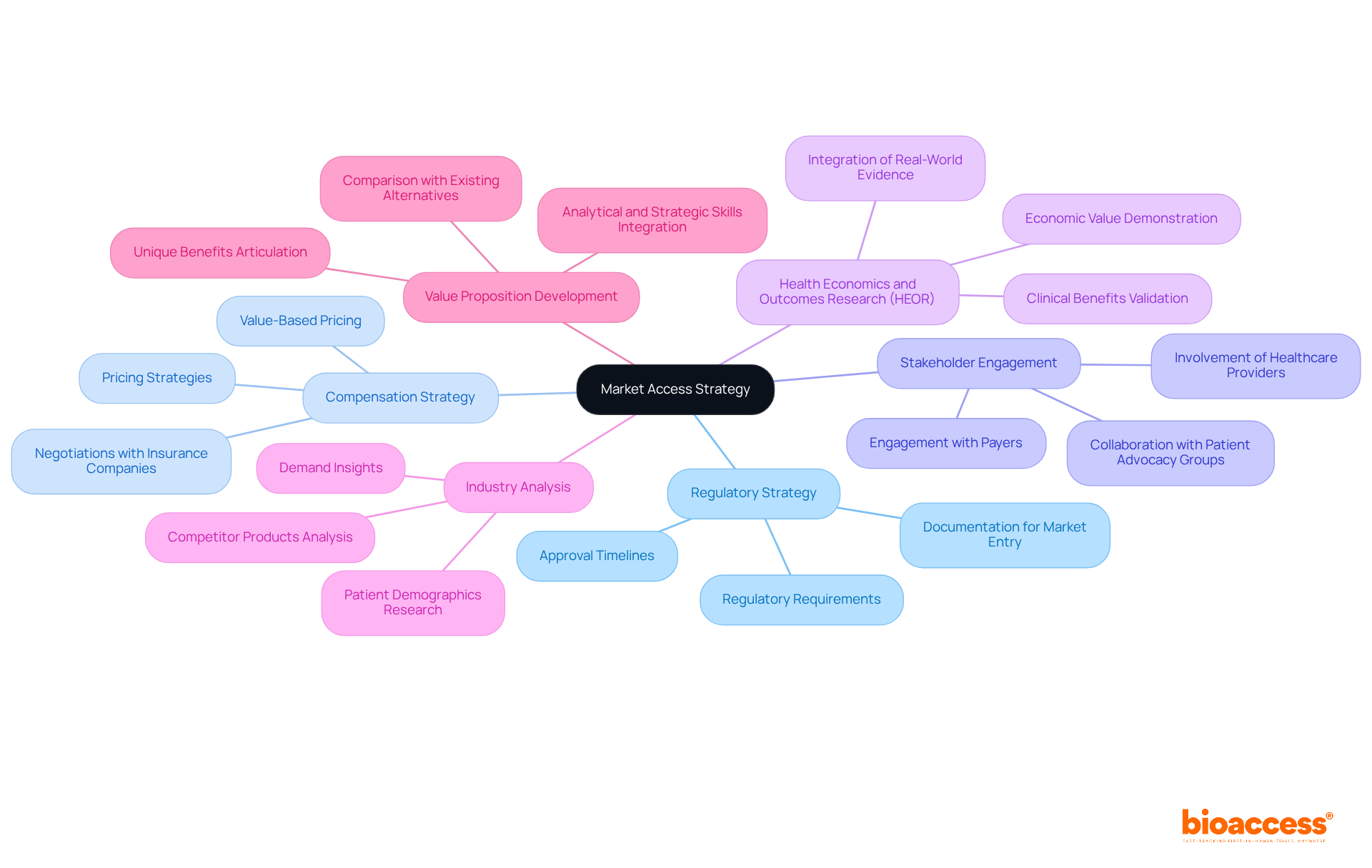


This article delves into the mastery of market access strategy within the pharmaceutical industry, underscoring the critical role effective strategies play in ensuring that new drugs reach patients and secure reimbursement from insurers. Key components such as:
are outlined, illustrating how a comprehensive market access strategy can significantly bolster a pharmaceutical company’s competitive edge.
In today’s complex landscape of drug approval and reimbursement, understanding these elements is essential. Companies that prioritize these strategies not only enhance their chances of success but also navigate the intricate web of regulations and market demands more effectively. Have you considered how your current approach aligns with these critical components?
Ultimately, the importance of a well-rounded market access strategy cannot be overstated. By integrating these elements, pharmaceutical companies can position themselves for greater success, ensuring that their innovations reach those who need them most.
Navigating the complex landscape of pharmaceutical market access is increasingly vital as companies strive to ensure their innovative therapies reach the patients who need them. The pressure to secure reimbursement and establish competitive pricing is intensifying, making a well-crafted market access strategy essential for success. As the industry faces evolving regulatory challenges and shifting payer expectations, pharmaceutical firms must adapt their approaches effectively to overcome these hurdles and thrive in a competitive market.
How can these firms rise to the occasion? By understanding the critical role of market access in the broader context of clinical research, they can position themselves to meet the demands of both patients and payers. This article will explore the Medtech landscape and the pivotal role of bioaccess in addressing key challenges, ultimately emphasizing the importance of collaboration and strategic action.
Market entry in the pharmaceutical industry is a complex process that ensures new drugs and therapies become available to patients and healthcare providers after receiving regulatory approval. This process goes beyond mere regulatory compliance; it encompasses strategic initiatives aimed at securing payment from insurers, establishing competitive pricing, and ensuring accessibility within the industry. Effective market access strategy pharma is crucial for maximizing the commercial potential of pharmaceutical products, ensuring they reach the patients who need them most.
These strategies involve a range of activities, including health technology assessments (HTAs), proactive stakeholder engagement, and the development of compelling value propositions that resonate with both payers and healthcare providers. Recent developments highlight the increasing complexity of market access, influenced by evolving compensation models and regulatory changes, such as the Inflation Reduction Act. This underscores the necessity for pharmaceutical companies to adapt swiftly to maintain access.
In Latin America, companies like bioaccess® provide strategic financial support and health economics solutions that are vital for tackling the region's unique challenges. For instance, bioaccess® utilizes pre-validated templates and tools, such as interactive pricing calculators and compensation rate databases, to streamline the funding process, significantly reducing approval timelines in countries like Chile and Peru. Their expertise in budget-impact models and value-based pricing strategies aids clients in developing a robust market access strategy pharma, particularly in environments with low compensation rates for innovative therapies.
Statistics indicate that incorporating a market access strategy pharma into corporate decision-making can yield a significant competitive edge. Firms that prioritize their market access strategy pharma are better equipped to navigate pricing challenges and secure advantageous funding pathways. Successful industry examples, such as reducing a digital health startup’s FONASA reimbursement timeline by nine months through GRD alignment, demonstrate that early engagement with external stakeholders—like payers and regulators—is essential for shaping policy discussions and overcoming entry barriers. As the landscape continues to evolve, the importance of a market access strategy pharma in the pharmaceutical sector is paramount, making it a fundamental component of any successful drug development strategy.

A successful market access strategy encompasses several essential components that pharmaceutical companies must prioritize to enhance their product's market success:
Regulatory Strategy: A comprehensive grasp of regulatory requirements across different sectors is essential. This includes familiarity with approval timelines and the necessary documentation to facilitate swift market entry. Companies are increasingly appointing global heads of value & access to navigate these complexities effectively, as noted in the 2023 Everest Group’s assessment.
Compensation Strategy: Establishing a clear compensation plan is crucial. This involves developing pricing strategies and engaging in negotiations with insurance companies to ensure favorable reimbursement conditions. The industry's shift towards value-based pricing underscores the importance of this component.
Stakeholder Engagement: Recognizing and actively involving key stakeholders—such as healthcare providers, payers, and patient advocacy groups—is crucial for gaining support and promoting acceptance in the industry. The role of access leaders is evolving to become central to enterprise strategy, shifting away from conventional commercial functions, as emphasized by industry specialists.
Health Economics and Outcomes Research (HEOR): Conducting HEOR studies is important to demonstrate the economic value and clinical benefits of the offering. These studies support reimbursement claims and help validate the item's position in the industry. The integration of real-world evidence is becoming increasingly vital in shaping these studies.
Industry Analysis: Thorough industry analysis is essential to collect insights on demands, competitor products, and patient demographics. This information guides strategic choices and assists in customizing the offering to satisfy particular consumer needs. Companies are utilizing advanced analytics to improve their research capabilities.
Value Proposition Development: Crafting a compelling value proposition is critical. This narrative should clearly articulate the unique benefits of the offering to both patients and healthcare providers, highlighting its advantages over existing alternatives. Top leaders in trade facilitation merge analytical skills with strategic insight to effectively convey this value.
By concentrating on these elements, pharmaceutical firms can develop a robust market access strategy that significantly improves the likelihood of success for their offerings in an increasingly competitive environment. Incorporating insights from the Inflation Reduction Act and leveraging case studies, such as the Health Technology Assessment Accelerator (HTAA) from IQVIA, can further enhance the effectiveness of these strategies.

The challenges presented by market access strategy pharma can impede the successful introduction of pharmaceutical products. Understanding these obstacles is crucial for navigating the complex landscape of clinical research.
Regulatory Hurdles: Navigating the intricate regulatory landscape is essential. Fragmented expectations from agencies like the FDA and EMA can lead to significant delays. For example, a mid-sized U.S. company experienced an 18-month marketing delay due to differing data submission requirements for a gene therapy. Companies must engage proactively with regulators and adopt ICH guidelines to facilitate simultaneous approvals across regions. Services offered by bioaccess, such as feasibility studies, compliance reviews, trial setup, and project management, can significantly aid in overcoming these regulatory challenges, particularly in Colombia, where INVIMA oversees medical device regulations as a Level 4 health authority.
Compensation Issues: Obtaining compensation remains a considerable obstacle, especially when products lack clear cost-effectiveness compared to existing therapies. Engaging with payers early—ideally 18-24 months before launch—can help address potential concerns and align expectations. Evidence generation, particularly through Health Economics and Outcomes Research (HEOR) studies, is crucial for substantiating reimbursement claims.
Industry Rivalry: The competitive environment can greatly influence entry into the sector. Conducting comprehensive market analysis to understand current offerings and their positioning is essential. Companies should develop adaptive strategies that consider the evolving dynamics of competition, especially as new therapies emerge.
Stakeholder Resistance: Opposition from healthcare providers or payers can hinder product availability. Establishing strong connections and effectively conveying the value proposition of the offering are vital strategies to mitigate this resistance. Engaging stakeholders early in the clinical development process fosters collaboration and support.
Data Gaps: Insufficient information regarding a product's effectiveness or economic impact can obstruct market entry. Investing in thorough HEOR studies can bridge these gaps, providing the necessary evidence to support reimbursement claims and enhance the product's competitive stance.
By proactively identifying and addressing these challenges, pharmaceutical companies can refine their market access strategy pharma, ultimately improving their chances of successful product launches. Leveraging bioaccess's expertise in clinical trial management can further enhance these efforts, ensuring compliance and effective project management throughout the process.

Mastering a market access strategy in the pharmaceutical industry is crucial for ensuring that innovative therapies reach patients efficiently and effectively. This strategic approach encompasses not only regulatory compliance but also initiatives aimed at securing reimbursement and establishing competitive pricing. The complexity of market access underscores the necessity for pharmaceutical companies to be agile and well-prepared to navigate the evolving landscape.
Key components of a successful market access strategy include:
Each of these elements plays a critical role in overcoming challenges such as regulatory hurdles, compensation issues, industry rivalry, and stakeholder resistance. By addressing these factors, companies can significantly enhance their chances of successful product launches and maintain a competitive edge in the market.
Ultimately, the significance of a well-defined market access strategy cannot be overstated. As the pharmaceutical landscape continues to evolve, embracing best practices and leveraging expert insights will be essential for companies seeking to thrive. By prioritizing market access, pharmaceutical firms not only ensure the availability of their products but also contribute to improved patient outcomes and the overall advancement of healthcare.
What is market access in the pharmaceutical industry?
Market access in the pharmaceutical industry refers to the complex process that ensures new drugs and therapies become available to patients and healthcare providers after receiving regulatory approval. It involves strategic initiatives aimed at securing payment from insurers, establishing competitive pricing, and ensuring accessibility.
Why is an effective market access strategy important for pharmaceutical products?
An effective market access strategy is crucial for maximizing the commercial potential of pharmaceutical products, ensuring they reach the patients who need them most.
What activities are involved in developing a market access strategy?
Activities involved in developing a market access strategy include health technology assessments (HTAs), proactive stakeholder engagement, and creating compelling value propositions that resonate with payers and healthcare providers.
How have recent developments affected market access in the pharmaceutical industry?
Recent developments, such as evolving compensation models and regulatory changes like the Inflation Reduction Act, have increased the complexity of market access, necessitating that pharmaceutical companies adapt swiftly to maintain access.
What role does bioaccess® play in market access in Latin America?
Bioaccess® provides strategic financial support and health economics solutions in Latin America, using pre-validated templates and tools to streamline the funding process and reduce approval timelines in countries like Chile and Peru.
How can a market access strategy impact corporate decision-making?
Incorporating a market access strategy into corporate decision-making can yield a significant competitive edge, allowing firms to navigate pricing challenges and secure advantageous funding pathways more effectively.
Can you provide an example of successful market access in the industry?
An example of successful market access is a digital health startup that reduced its FONASA reimbursement timeline by nine months through GRD alignment, demonstrating the importance of early engagement with external stakeholders like payers and regulators.
Why is early engagement with stakeholders important in market access?
Early engagement with external stakeholders is essential for shaping policy discussions and overcoming entry barriers, which can significantly impact the success of market access strategies.